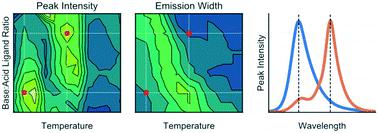当前位置:
X-MOL 学术
›
Mol. Syst. Des. Eng.
›
论文详情
Our official English website, www.x-mol.net, welcomes your
feedback! (Note: you will need to create a separate account there.)
Automated microfluidic screening of ligand interactions during the synthesis of cesium lead bromide nanocrystals
Molecular Systems Design & Engineering ( IF 3.2 ) Pub Date : 2020-03-02 , DOI: 10.1039/d0me00008f Shangkun Li 1, 2, 3, 4, 5 , Robert W. Baker 6, 7, 8, 9 , Ioannis Lignos 1, 2, 3, 4, 5 , Zhibo Yang 1, 2, 3, 4, 5 , Stavros Stavrakis 1, 2, 3, 4, 5 , Philip D. Howes 1, 2, 3, 4, 5 , Andrew J. deMello 1, 2, 3, 4, 5
Molecular Systems Design & Engineering ( IF 3.2 ) Pub Date : 2020-03-02 , DOI: 10.1039/d0me00008f Shangkun Li 1, 2, 3, 4, 5 , Robert W. Baker 6, 7, 8, 9 , Ioannis Lignos 1, 2, 3, 4, 5 , Zhibo Yang 1, 2, 3, 4, 5 , Stavros Stavrakis 1, 2, 3, 4, 5 , Philip D. Howes 1, 2, 3, 4, 5 , Andrew J. deMello 1, 2, 3, 4, 5
Affiliation

|
Varying the nature of the molecular surface ligands used to synthesize and stabilize lead halide perovskite nanocrystals provides a facile way of tuning and optimizing particle properties. However, the inherently complex reaction parameter space associated with perovskite nanocrystal synthesis complicates this, necessitating long-term and laborious experimentation to optimize conditions for a specific ligand set, and to compare nanoparticle properties across different ligand sets. In the current work, we present an automated microfluidic-based strategy for multidimensional parameter screening, seeking to maximize luminescence intensities and minimize emission bandwidths from quantum confined nanostructures, by monitoring variations in photoluminescence as a function of reaction temperature, base-to-acid ligand ratio, and ligand alkyl chain structure (linear versus branched). For a linear ligand pair (octylamine and octanoic acid), we find two reaction parameter sets that yield bright and narrow emission from nanosheets emitting at 460 nm (synthesized at 100 °C with a low base : acid ratio, FWHM = 25 nm) and nanowires emitting at 497 nm (synthesized at 140 °C with a high base : acid ratio, FWHM = 17 nm). Introducing branched ligands (2-ethylhexylamine and/or 2-ethylhexanoic acid) induces a red shift in emission and shows that bright and narrow emission can only be obtained from weakly quantum-confined nanostructures, within the reaction conditions studied. This work represents the first use of a rapid automated microfluidic system for the screening of ligand interactions during the synthesis lead halide perovskite nanocrystals.
中文翻译:

溴化铯铯纳米晶体合成过程中配体相互作用的自动微流控自动化
改变用于合成和稳定卤化钙钛矿纳米晶体的分子表面配体的性质,提供了一种调节和优化颗粒性质的简便方法。但是,与钙钛矿纳米晶体合成相关的固有复杂的反应参数空间使这一点变得复杂,需要进行长期而费力的实验以优化特定配体组的条件,并比较不同配体组的纳米粒子性能。在当前的工作中,我们提出了一种基于微流控的自动化多维参数筛选策略,旨在通过监测光致发光随反应温度,碱到酸配体的变化,来最大化发光强度并最小化量子受限纳米结构的发射带宽。比,与分支)。对于线性配体对(辛胺和辛酸),我们发现了两个反应参数组,它们从在460 nm处发射的纳米片(在100°C下合成,碱:酸比低,FWHM = 25 nm)产生亮而窄的发射。纳米线在497 nm处发射(在140°C时合成,具有高碱:酸比,FWHM = 17 nm)。引入支链配体(2-乙基己胺和/或2-乙基己酸)会引起发射红移,并表明在研究的反应条件下,只能从弱量子限制的纳米结构中获得亮而窄的发射。这项工作代表了快速自动化的微流控系统在合成卤化钙钛矿铅纳米晶体过程中用于筛选配体相互作用的首次应用。
更新日期:2020-03-02
中文翻译:

溴化铯铯纳米晶体合成过程中配体相互作用的自动微流控自动化
改变用于合成和稳定卤化钙钛矿纳米晶体的分子表面配体的性质,提供了一种调节和优化颗粒性质的简便方法。但是,与钙钛矿纳米晶体合成相关的固有复杂的反应参数空间使这一点变得复杂,需要进行长期而费力的实验以优化特定配体组的条件,并比较不同配体组的纳米粒子性能。在当前的工作中,我们提出了一种基于微流控的自动化多维参数筛选策略,旨在通过监测光致发光随反应温度,碱到酸配体的变化,来最大化发光强度并最小化量子受限纳米结构的发射带宽。比,与分支)。对于线性配体对(辛胺和辛酸),我们发现了两个反应参数组,它们从在460 nm处发射的纳米片(在100°C下合成,碱:酸比低,FWHM = 25 nm)产生亮而窄的发射。纳米线在497 nm处发射(在140°C时合成,具有高碱:酸比,FWHM = 17 nm)。引入支链配体(2-乙基己胺和/或2-乙基己酸)会引起发射红移,并表明在研究的反应条件下,只能从弱量子限制的纳米结构中获得亮而窄的发射。这项工作代表了快速自动化的微流控系统在合成卤化钙钛矿铅纳米晶体过程中用于筛选配体相互作用的首次应用。











































 京公网安备 11010802027423号
京公网安备 11010802027423号